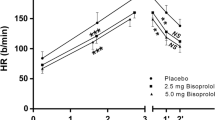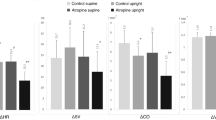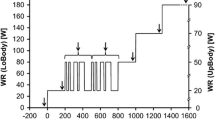Summary
The effects ofβ-blockade on the responses of oxygen uptake (\(\dot V_{{\text{O}}_{\text{2}} } \)), heart rate (HR) and blood lactate (La−) were examined during ramp cycle ergometer tests (50 W·min−1 ramp slope) in 8 healthy male volunteers. Each subject took placebo, or one of four different doses of three differentβ-blockers (propranolol, metoprolol or oxprenolol) 2 h prior to each test for a total of 15 exercise tests. (\(\dot V_{{\text{O}}_{\text{2}} } \)) was measured breath-by-breath, HR was sampled once per breath, and La− was obtained every minute. Linear regression analysis was applied to\(\dot V_{{\text{O}}_{\text{2}} } \) and HR data to obtain the kinetic parameter total lag time (TLT) and a slope value. La− was analyzed by a continuous exponential model with the lactate slope index (LSI) being derived from the individual response curves. Submaximal exercise HR was significantly depressed at the baseline as well as during the ramp tests byβ-blockade. TLT for HR was significantly affected byβ-blockade, with a dose dependent shift from a placebo value of 16 to 26 s with placebo to a value of -40 to -60 s at the highest dose. Slope of HR was significantly depressed relative to placebo.\(\dot V_{{\text{O}}_{\text{2}} } \) kinetics assessed by TLT were not significantly affected byβ-blockade. This slope of the\(\dot V_{{\text{O}}_{\text{2}} } \) vs work rate relationship was significantly less than placebo only at the highest dose ofβ-blocker. The LSI was not significantly affected byβ-blockade. In contrast with the clear impairment of HR response to exercise duringβ-blockade, both the\(\dot V_{{\text{O}}_{\text{2}} } \) and La− responses appear to be relatively unaffected byβ-blockade during ramp exercise tests. However, the significant change in slope of the\(\dot V_{{\text{O}}_{\text{2}} } \) vs work rate relationship at the highest dose level indicates that the oxygen transport system is in fact impaired byβ-blockade. It is concluded that the ramp exercise test is not a sensitive means of detecting changes in oxygen transport kinetics during exercise withβ-blockade. Further, there were no differences between the threeβ-blocking drugs.
Similar content being viewed by others
References
Astrand PO, Rhyming I (1954) A nomogram for calculation of aerobic capacity (physical fitness) from pulse rate during submaximal work. J Appl Physiol 7:218–227
Bakker HK, Struikenkamp RS, DeVries GA (1980) Dynamics of ventilation, heart rate, and gas exchange: sinusoidal and impulse work loads in man. J Appl Physiol 48:289–301
Beaver WL, Lamarra N, Wasserman K (1981) Breath-by-breath measurement of true alveolar gas exchange. J Appl Physiol 51:1662–1675
Bruce RT, Hossack KF, Kusumi F, Clarke LJ (1979) Acute effects of oral propranolol on hemodynamic responses to upright exercise. Am J Cardiol 44:132–140
Eckoldt K, Pfeifer B, Schubert E (1980) Sympathetic and parasympathetic innervation of the heart at rest and work in man as judged by heart rate and sinus arrhythmia. In: Koepchen HP, Hilton SM, Trzebski (eds) Central Interaction Between Respiratory and Cardiovascular Control Systems. Springer, New York, pp 216–222
Epstein SE, Robinson BF, Kahler RL, Braunwald E (1965) Effects ofβ-adrenergic blockade on the cardiac response to maximal and submaximal exercise in man. J Clin Invest 44:1745–1753
Franciosa JA, Johnson SM, Tobian LJ (1980) Exercise performance in mildly hypertensive patients: Impairment by propranolol but not oxprenolol. Chest 78:291–299
Fujihara Y, Hildebrandt J, Hildebrandt JR (1973) Cardiorespiratory transients in exercising man. II. Linear models. J Appl Physiol 35:68–76
Greco EC, Baier H, Saez A (1986) Transient ventilatory and heart rate responses to moderate non abrupt pseudorandom exercise. J Appl Physiol 60:1524–1534
Hansen JF, Hesse B, Christensen NJ (1978) Enhanced sympathetic nervous activity after intravenous propranolol in is chemic heart disease: plasma noradrenaline, splanchnic blood flow and mixed venous oxygen saturation at rest and during exercise. Eur J Clin Invest 8:31–36
Hughson RL (1984a) Alterations in the oxygen deficit-oxygen debt relationships withβ-adrenergic receptor blockade in man. J Physiol 349:375–387
Hughson RL (1984b) Dose-response study of maximal exercise with propranolol, metoprolol, and oxprenolol in normal subjects. J Cardiac Rehab 4:50–54
Hughson RL, Inman MD (1986) Oxygen uptake kinetics from ramp work tests: variability of single teat values. J·Appl Physiol 61:373–376
Hughson RL, Morrissey MA (1983) Delayed kinetics of 716-01 in the transition from prior exercise. Evidence for O2 transport limitation of\(\dot V_{{\text{O}}_{\text{2}} } \) kinetics: A review. Int J Sports Med 4:31–39
Hughson RL, Smyth GA (1983) Slower adaptation of\(\dot V_{{\text{O}}_{\text{2}} } \) to steady state of submaximal exercise withβ-blockade. Eur J Appl Physiol 52:107–110
Hughson RL, Weisiger KH, Swanson GD (1987) Blood lactate concentration increases as a continuous function in progressive exercise. J Appl Physiol 62:1975–1981
Kaiser P (1984) Physical performance and muscle metabolites duringβ-adrenergic blockade in man. Acta Physiol Scand [Suppl] 536:1–53
Karlsson H, Wigertz O (1971) Ventilation and heart rate responses to ramp-function changes in work load. Acta Physiol Scand 81:215–224
Karlsson J, Dlin R, Kaiser P, Tesch PA, Kaijser C (1983) Muscle metabolism, regulation of circulation andβ-blockade. J Cardiac Rehab 3:404–420
Linnarsson D (1974) Dynamics of pulmonary gas exchange and heart rate changes at start and end of Exercise. Acta Physiol Scand [Suppl] 415:1–68
Maciel BC, Gallo Jr L, Marin Neto JA, Lima Filho EC, Martins LEB (1986) Autonomic nervous control of the heart rate during dynamic exercise in normal man. Clin Sci 71:457–467
MacFarlane BJ, Hughson RL, Green HJ, Walters DA, Ranney DA (1983) Effects of oral propranolol and exercise protocol on indices of aerobic function in normal man. Can J Physiol Pharmacol 61:1010–1017
McSorley PD, Warren DJ (1978) Effects of propranolol and metoprolol on the peripheral circulation. BrMed J2:1598–1600
Pearson SB, Banks DC, Patrick JM (1979) The effect ofβ-adrenoceptor blockade on factors affecting exercise tolerance in normal man. Br J Clin Pharmacol 8:143–149
Petersen ES, Whipp BJ, Davis JA, Huntsman DJ, Brown HV, Wasserman K (1983) Effects ofβ-adrenergic blockade on ventilation and gas exchange during exercise in humans. J Appl Physiol 42:1306–1313
Robinson BF, Epstein SE, Beiser GD, Braunwald E (1966) Control of heart rate by the autonomic nervous system. Studies in man on the interrelation between baroreceptor mechanisms and exercise. Circ Res 29:400–411
Twentyman OP, Disley A, Gribbin HR, Alberti KGMM, Tattersfield AE (1981) Effect ofβ-adrenergic blockade on respiratory and metabolic responses to exercise. J Appl Physiol 51:788–793
Versteeg PGA, Sampurno SB, Sipkema P, Elzinga G (1981) Control of cardiac output in exercising dogs using different types of workload. Cardiovasc Res 15:151–158
Whipp BJ, Davis JA, Torres F, Wasserman K (1981) A test to determine parameters of aerobic function during exercise. J Appl Physiol 50:217–221
Whipp BJ, Ward SA, Kamarra N, Davis JA, Wasserman K (1982) Parameters of ventilatory and gas exchange dynamics during exercise. J Appl Physiol 52:1506–1513
Wigertz O (1971) Dynamics of respiratory and circulatory adaptation to muscular exercise in man. A system analysis approach. Acta Physiol Scand [Suppl] 363:1–32
Williams RS, Caron MC, Daniel K (1984) Skeletal muscleβ-adrenergic receptors: variations due to fiber type and training. Am J Physiol 246:E 160-E 167
Author information
Authors and Affiliations
Additional information
Supported by the Heart and Stroke Foundation of Ontario, and the Natural Sciences and Engineering Research Council of Canada
Rights and permissions
About this article
Cite this article
Hughson, R.L. Ramp work tests with three different beta-blockers in normal human subjects. Europ. J. Appl. Physiol. 58, 710–716 (1989). https://doi.org/10.1007/BF00637381
Accepted:
Issue Date:
DOI: https://doi.org/10.1007/BF00637381




